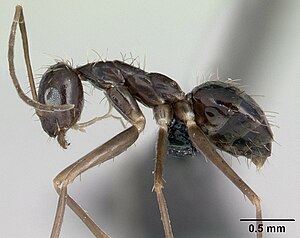Paratrechina longicornis
| Dieser Artikel wurde zur Überarbeitung vorgeschlagen. Hilf mit, ihn zu verbessern!
Begründung: Gliederung, Inhalt, Lesbarkeit --DmdM 16:26, 10. Feb. 2012 (CET) |
Hier vorläufig ein Link zu dieser pestant: http://keys.lucidcentral.org/keys/v3/PIAkey/Fact_Sheets/Paratrechina_longicornis.html
Weitere Informationen sind über die beiden folgenden Links zu erhalten:
http://www.newscientist.com/article/dn20072-zoologger-invasion-of-the-crazy-incestuous-ants.html
Invasion of the crazy incestuous ants – Paratrechina longicornis
http://rspb.royalsocietypublishing.org/content/early/2011/01/29/rspb.2010.2562 Sib mating without inbreeding in the longhorn crazy ant Morgan Pearcy, Michael A. D. Goodisman and Laurent Keller Proc. R. Soc. B
- Author and address for correspondence: Evolutionary Biology and Ecology, Université Libre de Bruxelles, Avenue F.D. Roosevelt, 50, 1050 Brussels, Belgium (mpearcy@ulb.ac.be).
Abstract
Sib matings increase homozygosity and, hence, the frequency of detrimental phenotypes caused by recessive deleterious alleles. However, many species have evolved adaptations that prevent the genetic costs associated with inbreeding. We discovered that the highly invasive longhorn crazy ant, Paratrechina longicornis, has evolved an unusual mode of reproduction whereby sib mating does not result in inbreeding. A population genetic study of P. longicornis revealed dramatic differences in allele frequencies between queens, males and workers. Mother–offspring analyses demonstrated that these allele frequency differences resulted from the fact that the three castes were all produced through different means. Workers developed through normal sexual reproduction between queens and males. However, queens were produced clonally and, thus, were genetically identical to their mothers. In contrast, males never inherited maternal alleles and were genetically identical to their fathers. The outcome of this system is that genetic inbreeding is impossible because queen and male genomes remain completely separate. Moreover, the sexually produced worker offspring retain the same genotype, combining alleles from both the maternal and paternal lineage over generations. Thus, queens may mate with their brothers in the parental nest, yet their offspring are no more homozygous than if the queen mated with a male randomly chosen from the population. The complete segregation of the male and female gene pools allows the queens to circumvent the costs associated with inbreeding and therefore may act as an important pre-adaptation for the crazy ant's tremendous invasive success.
Hier wird beschrieben, dass P. longicornis trotz permanenter Inzucht keine Inzuchtdepression erleidet. Die Ursache ist kompliziert: Königinnen entstehen als Klone ihrer Mutter aus diploiden Eiern (parthenogenetisch), besitzen also nur deren Erbmaterial. Männchen sind stets genetisch identische Kopien ihrer Väter, entstehen also nicht aus haploiden Eiern mit mütterlichem Erbmaterial. Nur Arbeiterinnen entstehen normal aus befruchteten Eiern. Sie selbst pflanzen sich jedoch nicht fort.
Somit bleiben die männlichen und weiblichen Genpools dauerhaft getrennt, so dass es auch bei Geschwisterpaarung nicht zu Inzuchterscheinungen kommen kann.
Das - ungewöhnliche - System wird als Präadaptation (Voraus-Anpassung) dafür gesehen, dass diese extrem invasive Art neue Lebensräume auch dann erfolgreich kolonisieren kann, wenn nur sehr wenige Individuen an einen geeigneten Ort verschleppt werden.
